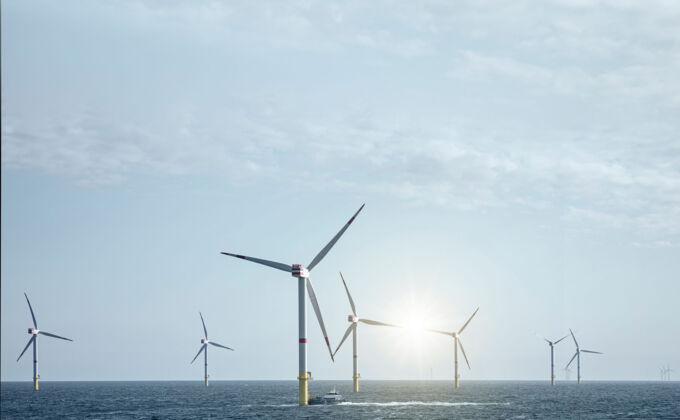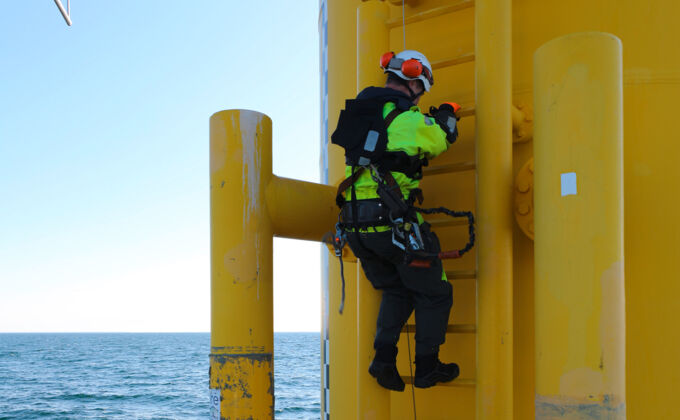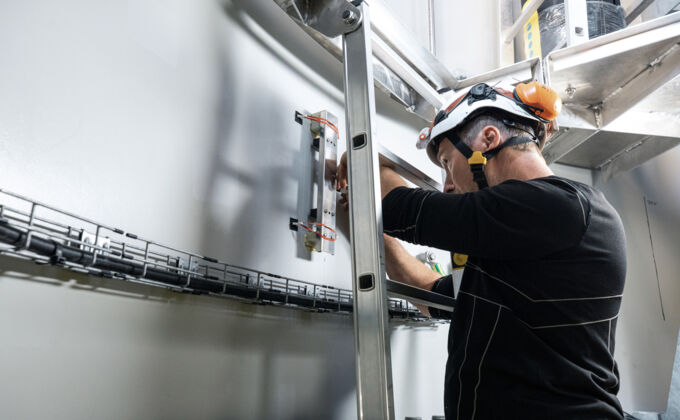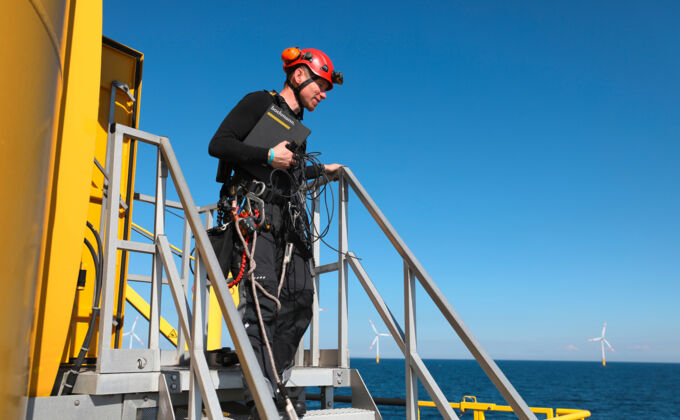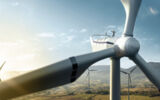
Through the Waves
and into the Air
Offshore installation with the Bachmann offshore crew.
The job description for the Bachmann offshore crew is to equip existing wind turbines with new sensor and monitoring technology. They complete the installation, document everything, and ensure that the collected measurement data provides exactly what’s needed for safe and economical turbine operation. Furthermore: Their experience in the field is then fed back into the ongoing development of systems and solutions at Bachmann. We accompanied the team for a day during their assignment in the North Sea.
Thomas Stauche stands on the ladder to mount a new sensor. He is happy and relaxed – despite being about 100 meters up the tower of a wind turbine. Just a few days ago he was in Japan, now he’s in Germany, more precisely: he’s in the middle of the North Sea. Thomas is part of the Bachmann offshore team, which works on offshore pilot plants worldwide. The team consists of five people. Technicians, engineers, allrounders - that's probably the best way to describe the squad. "We could do with a few more of this kind of employee. But all-round specialists are very rare on the labor market," laments Holger Fritsch, Managing Director at Bachmann Monitoring, the competence center for condition monitoring within the Bachmann Group.
Danger. Everywhere.
Despite the calm that Thomas exudes, working on a wind turbine brings with it a large portion of thrills and risks. Even though everyone is well secured when working at height, and they have all completed the appropriate training, working on an offshore turbine remains dangerous. Special care and caution are required with each move and every step. In particular, one of the greatest potential hazards is moving between the ship or helicopter and the wind turbine.
You don’t just need to be physically fit; you need to have your head in the right place if you want to make it safely onto the wind turbine.
Today's approach to the Nordsee One wind farm is already turbulent: With a swell of more than three meters, there was talk of canceling the trip to the farm. After some delays, the gods on high give us the all clear. The trip involves an hour-long ride through the North Sea waves. Then comes the risky crossing onto the rig: the ship’s captain holds the bow against the monopile at full thrust. And here we find a ladder. The ship rises and falls, squeaking and crashing to the rhythm of the waves - swell is just at the limit for a permissible climb. On the command of the boarding chief, we set off to "3-2-1": grabbing the ladder and making the 20-meter climb to the supply platform as fast as possible. The first five or six steps must be climbed quickly and safely, otherwise the ship will catch you on the next wave. Thomas wouldn't want to do any other job. For him, this is where future technology and modern adventure combine into a fulfilling symbiosis.
Adventure? Adventure!
It’s rare for a real-life system to conform to the original plans, which can be challenging when the team arrives on site: "You have to be able to improvise out here," says Frank Köllner. Sometimes the ladder is mounted in a different place in the tower. And you have to be prepared for unexpected mid-levels and unmarked obstacles. In such cases, cable routing has to be rearranged without further ado, which involves selecting new mounting surfaces. "None of this would be too dramatic if you could step outside to your service van for a moment and grab some additional materials," laughs Frank. "But out here, it's just the open sea." All the materials the team brings with them have to fit; connecting cables are sized almost to the meter. Things get particularly tricky if parts are missing and continuing to work is no longer possible: A whole day can be lost. Days at sea are expensive, and every minute at the plant counts.
Experience. In every product.
The team's offshore turbine experience is invaluable because it gets fed back into Bachmann’s R&D, helping to make the products what they are: Solutions that exactly meet the requirements on site. Durable, reliable products with efficient, uncomplicated installation and commissioning. This is the only way for the installation crew to meet the tight time windows available.
The fruits of this experience are visible, for example, in the development of the Bachmann Cantilever Sensor (CLS). As well as long-term stability, the biggest emphasis was on simple installation. Why? Well, anyone who has ever retrofitted a sensor 140 meters up a rotor blade at sea during wind force 5 to 6 knows exactly why: The turbine wobbles and sways so much that exact mounting with conventional material is impossible. For many sensors on the market, installation is extremely time-consuming and also prone to error - often due to the installation accuracy required by the system. Moreover, components just don’t stand up to the harsh field of application. "The CLS just does it better," grins Thomas Stauche , who is currently connecting a cable to the sensor. "I can easily attach it even during poor conditions, and it is extremely robust."
No failures. Year on year.
In the end, only one thing really matters to the operator: How cost-effective is the solution? In addition to low capital expenditure, operators demand low installation and commissioning costs. It goes without saying that everything has to run smoothly for many years, with no breakdowns.
Operators therefore appreciate teams like Bachmann's, who take a holistic view of the entire retrofit, conversion or initial installation, ensuring that systems function right from the start. "A supposedly cost-effective sensor and system solution can quickly lead to one or two days of additional installation work," Holger Fritsch notes. "This blows away the supposed cost advantage of cheaper hardware."
Our customers. Our partners.
With more than 50 years of experience in the world of automation, and over 20 years in the field of wind power plants, Bachmann stands out with its future-proof and robust installations. From the overall automation solution, to the energy management system; from the transfer of energy into the grid, to the tailor-made structural monitoring solution - more than 140,000 installed systems and connected services worldwide pretty much speak for themselves.
With Bachmann. For a secure energy future.

